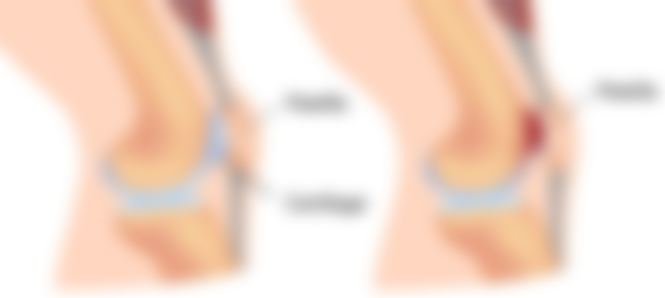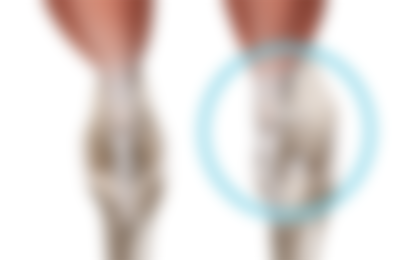Even for young women who are in excellent physical condition, the knees can become the true Achilles heel of their bodies, that is, the area most vulnerable to injury.
The massive participation of women in physical conditioning programs and sports exposes their knees to a variety of injuries.
Although men and women generally suffer the same number of injuries to their knees, they tend to suffer more violent and sudden injuries caused by the heavy falls or collisions that occur in their sports, such as soccer or basketball.
Even among dancers, women are more susceptible to injury than men. The anatomy of women predisposes them to “abuse” injuries, which develop gradually. Because a woman's pelvis is generally wider than a man's, the femur connects to the knee joint forming a steeper angle.

Do you know what chondromalacia is?
This feature of the pelvis causes the femur to rotate slightly inward. This angle adds additional stress to the joint and predisposes to misalignment injuries: the patella or patella can wobble and slide outward, causing over time to weaken and soften the cartilage overlying it. This annoying condition, called chondromalacia sometimes referred to as "runners knee" is the most common injury in women. Chondromalacia is characterized by the following symptoms:
Pain above or behind the kneecap when pressed with the hand.
Pain when the knee is bent at an angle greater than 45 degrees.
Crepitus when flexing and straightening the leg, going up or down steps.
Recurrent inflammation caused by fluid accumulation in the capsule that surrounds the kneecap.

Women as well as men who participate in activities that lead to repeated knee impacts, such as jogging, high bench aerobics, are especially exposed to this type of injury.
Chondromalacia can originally be caused by a direct fall on the knee. Trauma can also result from progressive wear of the smooth surface of the posterior aspect of the patella, as just mentioned.
The incorrect alignment of the patella due to subluxation or dislocation is another cause of chondromalacia. In this particular case, a common pattern is manifested that comprises the following factors:

A malformed patella that does not have the medial and lateral facets or, in extreme cases, only has one lateral facet.
A taut lateral capsule that pulls on the kneecap, causing it to move toward the outside of the knee.
A lateral vessel (quadriceps muscle) that displaces the patella outward as it contracts.
A foot that shows provation (fallen arch) putting additional stress on the knee.
Femoral anteversion of the hips (an abnormal rotation of the femur at the hip joint).
Valgus alignment of the knees (double-legged knees).
A shallow patellar groove.
A flat kneecap.
A combination of these factors usually occurs in the same person, causing instability. In extreme cases, such as athletes and dancers with lax ligaments, the patella is completely dislocated from Its groove and must be immediately put into place.
Overweight and other influencing factors
Since we mentioned the ligaments, it is important to note that women are more prone to injury to the ligaments of their knees, those bands of elastic tissue that join the bones of the legs and the patella.

Women's ligaments tend to be looser than men's, making them more susceptible to overstretching or tearing when they participate in sports or physical activities that require a great deal of rotation, jumping, and lateral movement.
These activities include high- and low-impact aerobics, dance and ballet, martial arts, volleyball, and basketball. And in men, soccer.
Pregnant women are even more vulnerable to problems with their ligaments. The extra weight puts pressure on the knees, and the pregnancy hormones that soften the ligaments in the pelvis also soften those in the knees.
Any excess body weight is bad for the knees. It is estimated that each additional pound of weight creates four kilos of pressure on the kneecap just when walking. Each additional kilo adds 10 kilos of pressure when climbing hills or stairs and 17 kilos when running or practicing high-impact aerobics. So five kilos of overweight can put up to 25 kilos of pressure on the kneecap.

Protect your knees
For susceptible women, even daily activities such as climbing stairs, kneeling, and bending over can cause pain. Knee injuries can be prevented if you have a knee evaluation before engaging in strenuous physical activities. But regardless of that, strengthening and toning your leg muscles will help prevent injury. The muscles that make up the quadriceps keep the kneecap on track.
In conjunction with the muscles in the back of the legs, the flexor muscles provide balance, stability, and shock absorption. The stronger your muscles, the less stress is placed on joint surfaces and ligaments and cartilage.

Multi-strength machines, especially leg extension and flexion machines, are helpful in strengthening these muscles. We recommend going little by little, using little weight, a limited range of motion. The leg should not be fully stretched and when bending it should be aimed at an angle of 45 degrees instead of 90 degrees.
We also recommend "cross training", combining various disciplines to strengthen as many muscles as possible.
Dislocations and atetlas
Triathletes (they alternate swimming, jogging and cycling) suffer fewer knee injuries than marathoners. To avoid injury when training with stationary bikes, we recommend keeping the seat elevated and the resistance low. Stairs should be adapted for frequent short steps rather than long steps that require a lot of force and place excessive stress on the joint.

Another of the injuries caused by this anatomical difference between men and women is the dislocation or dislocation in which the patella moves away from the patellar femoral groove. Dislocations are caused by serious falls or accidents typical of sports activities that impose a violent lateral rotation force on the knee that is in a support position.
An acute dislocation can predispose the knee to other similar events. Here are some of the factors that influence the recurrence of dislocations.
A valgus knee that skews the patella laterally or misaligns the extensor mechanism.
An elongated patellar tendon.
A poor internal vastus.
It is important that when you suffer from this type of injury, visit the doctor as he will give you instructions on what to do in these cases.
Until a next post. Greetings.
Main picture: https://www.tulsapain.com/blog/why-knee-so-vulnerable-injuries







Its a real helpful article. Thanks for sharing this dear. Also don't forget to subscribe me as I don't.